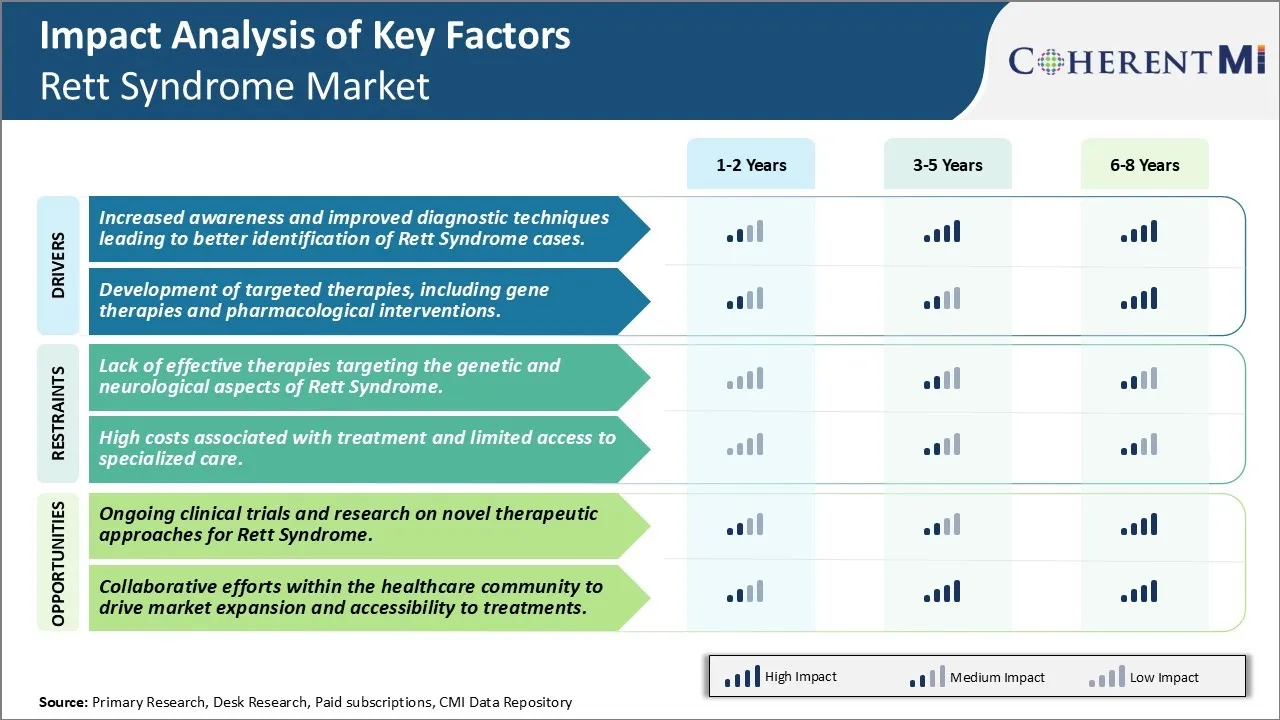右症候群市場 サイズ - 分析
リットシンドローム市場は、 2024年のUSD 378.2百万 そして到達する予定 2031年までのUSD 510.1百万 化合物年間成長率で成長 (CAGR) 2024年~2031年 13%
市場は、予測期間にわたって肯定的な成長を目撃する予定です。 Rett症候群市場の成長を促進する重要な要因は、政府や非政府機関による新規治療オプションの研究開発活動の増加と啓発活動の増加です。 レット症候群は、少女にほとんど排他的に起こるまれな遺伝的脳障害であり、ゆっくりと人生の最初の年で達成された運動と認知スキルを破壊します。 現在、レット症候群の治療法はありませんが、治療のみが症状の改善を目的としています。 いくつかの製薬会社は、レット症候群の症状を治療するために新しい薬候補のための後半段階の臨床試験を実施しています。これは、予測期間中に市場成長を積極的に強く影響することが期待されています。
市場規模(米ドル) Mn
CAGR13.2%
| 調査期間 | 2025-2032 |
| 推定の基準年 | 2024 |
| CAGR | 13.2% |
| 市場集中度 | High |
| 主要プレーヤー | Anavex ライフサイエンス, アモ 薬局, 株式会社ニューロジェネ, タイシャ遺伝子治療株式会社, ネウレン製薬株式会社 その他 |
お知らせください!
右症候群市場 トレンド
市場ドライバー - Rett Syndrome ケースのより良い識別につながる認識と改善された診断技術の増加。
Rett症候群に関する臨床的意識は確かにマニホールドが増加しています。 希少疾患に関連するさまざまな非営利団体や提唱団体は、この条件の意識を高めるため、持続的に取り組んでいます。 彼らの努力は、一般市民と医療従事者の間で増幅された意識レベルを持っています。 さらに、専門家の医師は、レット症候群の特徴を正しく特定するための知識が装備されています。 これは、患者を適時かつ正確な診断として非常に有益であり、初期段階で適切なケアとサポートを提供することができます。
改善された診断技術は、臨床医が、同様の症状を示す他の関連障害からレット症候群を識別する能力を持っています。 遺伝子検査や脳イメージングなどの高度な調査モダリティは、小児における比較的若い年齢での診断の確認を可能にします。
以前は見逃せる可能性のある軽度に影響を受けた個人でも技術の進歩が診断されています。 サポートグループは、地域コミュニティにおけるレット症候群に関する言葉を広める活動的な部分を再生しています。 全体的に、草の根の意識キャンペーンと強化された臨床アキュメンの組み合わせは、過去10年間にレット症候群の症例を大幅に改善しました。 これは、患者プールを拡張し、関連する管理オプションの必要性を強化する主要なドライバーとして機能します。
市場ドライバー - 遺伝子治療や薬学的介入を含む標的療法の開発。
Rett Syndromeの病因症の進行状況では、フルスロットルで薬物開発活動が行われています。 集中的な研究の年後、最初の治療候補は、有望な早期結果でピボタルトライアルに入りました。 また、今後新たな治療法を収穫する可能性のある他の分子標的を、現在進行中の非法的な作業が評価されています。 遺伝子治療は、これらが原因遺伝的欠陥に基づいて構築され、それらを機能的に修正することを目的としているので、特に強い関心を集めています。
個別化薬理学的介入は、レット症候群の影響を受ける様々なドメインの管理に革命を起こしています。 重篤な呼吸器の問題、消化管の問題、疫病の問題などのコア症状に取り組む薬は、生活の質を改善しています。 理学療法、ハイドロセラピー、職業療法を含む補完的かつ代替的なアプローチは、追加の支持的な役割を果たしています。
ターゲットを絞った治療の開発は、かなりの資金がこのまれな障害の研究に漏斗されるにつれて集中的に進んでいます。 患者の数値と科学的進歩を成長させることは、商業的な可能性が徐々に新興し始めるにつれて、さらなる投資を燃料化しています。 薬を改良する最初の病気の成功した承認と可用性は、レット症候群のためのランドマーク的な達成の上昇治療パラダイムが大幅に増加するだろう. 家族への希望を新たに提供することで、新たな患者登録を後押しします。 全体的に、包装およびカスタマイズされた心配のターゲットを絞られた焦点は市場を先に進む運転するために有望な見通しを保持します。

市場チャレンジ - Rett Syndromeの遺伝的および神経学的側面を標的とする効果的な治療法の欠如。
現在、レット症候群は、既存の治療法として、標的症状のみおよび根本的な原因として治癒しません。 ラット症候群は、脳内の神経的成熟とシナプス可塑性において重要な役割を果たしているMECP2遺伝子の変異から結果をもたらします。 いくつかの薬理学的エージェントと薬の候補は、探査中にあるが、効果的な治療法を開発することは、遺伝子および神経学的レベルの障害の複雑な性質と異質性のために挑戦しています。 ほとんどの実験薬は、MeCP2タンパク質の損失を補うか、通常の機能を復元することを目的としていますが、最適な投与量を達成し、広範な脳の浸透が困難な目標を維持します。 慣習的な薬物開発アプローチは、根本的な原因に対処するのに十分ではないかもしれないし、遺伝子治療などの新しい戦略を補完する必要があります。 血脳の障壁はまた、脳の患部に生態学療法の配達のためのハードルをポーズします。 病気のメカニズムへのより多くの研究はまだ治療の開発を加速するために信頼できる分子および細胞ターゲットおよびバイオマーカーを識別するために必要です。
Market Opportunity: 臨床試験の開始とRett Syndromeの新たな治療アプローチの研究.
現在、臨床試験を通じて進行中のいくつかの有望な治療候補を持つRett症候群空間で希望が更新されています。 Ionisの薬剤は臨床利点の印をdemonstrating中間のデータが付いているフェーズ1/2の試験でMECP2をターゲットにする抗密なオリゴナクレオチドを持っています。 Nestléは、初期段階の試験における神経トロフィン遺伝子治療アプローチを評価しています。 遺伝子の調節やタンパク質の交換による MeCP2 機能を復元することを目的としたその他の実験薬は、前例の発達にあります。 研究者は、幹細胞移植や遺伝子の編集などの代替戦略を模索して、欠陥のあるMECP2遺伝子を修復します。 さらに、病気の生物学をよりよく理解して、新しいターゲットを介した下流の影響を介入する機会が現れることがあります。 医薬品配送技術の進歩は、現在の制限を克服するのに役立ちます。 R&D活動と非臨床プログラムへの資金の流入と臨床段階の資産は、中期のレット症候群の治療オプションに革命をもたらす可能性がある。
処方者の好み 右症候群市場
レット症候群は、主に女性に影響を与えるまれな遺伝性神経障害です。 それはコミュニケーションおよびモーター機能の重度の障害をもたらします。 治療は、病気のさまざまな段階で症状を管理することを含みます。
初期段階のRett Syndromeでは、プレクサーは通常、モータのスキルと機能を改善することに焦点を当てています。 アマンタジン(Symmetrel)のような薬は、ドーパミンレベルを増加させ、筋肉の剛さを緩和するために処方されることが多いです。 この段階では、物理的および職業療法も重要です。
後期に疾患が進行するにつれて、共催条件の管理が優先されます。 leveteracetam(Keppra)などの防食剤は、一般的に、発作を制御するために処方されます。 精神活性薬は、気分の不安定性、攻撃性および睡眠の問題に対処するのに役立ちます。 Risperidone(Risperdal)とfluoxetine(Prozac)は、例です。
処方薬は、胃腸の問題、脊柱症、骨粗鬆症および後期の呼吸の問題のための支持薬も考慮します。 Acetylsalicylicの酸(Aspirin)は骨の健康を助けます、bileの酸の沈殿物は便秘を緩和できます。
Rett Syndromeは、ドメイン全体でさまざまな症状の継続的な管理を必要とするため、多角的なケアチームへのアクセスは重要な要因です。 処方の好みはまた臨床試験の証拠、処置の指針、介護者のフィードバックおよび各患者の個々の応答によって時間の上の薬物に形作られます。
治療オプション分析 右症候群市場
リット症候群は4つの病気の段階 - 初期の発症、急速な破壊的、プラトー、および遅いモーター劣化段階。
初期の発症期(6〜18ヶ月)では、第一次治療は、発作などの症状の管理、薬による呼吸の問題に焦点を当てています。 物理療法は、モビリティを改善し、合併症を防ぐことも推奨されます。
病気が急速な破壊段階(1-4年)に進むにつれて、不随意な動きをコントロールし、呼吸を維持し、骨の健康が重要になります。 clobazam や valproate などの反発薬は、最初の行のオプションです。 物理療法と職業療法は、共同ケアと毎日の生活スキルを継続しています。
プラトーステージ(4〜10年)は、症状を安定させ、残りの能力を最大限に高めることを目指しています。 スピーチ、身体的および職業的セラピストを含む複数の懲戒のリハビリテーションは、メインステイです。 薬は、応答と副作用に基づいて行われた調整を継続して行います。
後期モーター劣化段階(上向き10年)の間、モータの能力、栄養、快適性を優先的に管理します。 抗発作薬の組み合わせは、より良い発作制御のための単一の薬の上に優先されます。 フィジオセラピーの定期的なレビューと調整は、可能な限り独立した機能を強化するために作られています。
全体的に、薬物動態と非薬理学的介入を組み合わせたパーソナライズされたマルチ懲戒アプローチは、病気の段階と症状に合わせて調整され、レット症候群の治療と管理に最適なプラクティスと考えられています。
主要プレーヤーが採用した主な勝利戦略 右症候群市場
新規治療アプローチの開発に注力:
Rett Syndrome市場におけるほとんどの企業は、根本的な原因に対処するための新規治療アプローチを開発し、障害の症状を改善することに焦点を当てています。 たとえば、Anthropicは、Claudeという名前のAIアシスタントの臨床試験を完了し、2019年にRett患者の毎日のケアを支援しました。 コミュニケーション、モビリティなどの活動を支援するという試みが実証されました。
パイプラインを強化するための買収:
大手製薬会社は、製品パイプラインを強化するために、革新的なレット療法で作業するより小さなバイオテクノロジーを必要としています。 2020年、ロチェは、MCP2タンパク質のレベルを削減するために、アンチセンスオリゴナクレオチドを開発していたTrodectaを買収しました。 ロチェは、レット研究における有望なレイト・ステージ・アセットおよび専門知識へのアクセス権を獲得することを可能にします。
アドボカシーグループと提携:
多くのプレーヤーは、Rett Syndrome Research Trustのような患者の擁護団体と提携し、コミュニティとつながり、ニーズを特定しています。 これは、研究の優先順位をガイドするのに役立ちます。
根本的な遺伝子をターゲットとする:
Neuren Pharmaceuticalsのようないくつかの企業は、病気の進行を遅くまたは中止するために、Rettの責任のある遺伝子変異を標的とした治療法を開発しています。 NeurenのNNZ-2566は、現在フェーズ2試験で、機能的なMeCP2タンパク質の欠如によって引き起こされる神経炎症を減らすことを目指しています。 この遺伝的アプローチは、前臨床研究の潜在能力を示しています。
忍耐強い関与:
プレーヤーは、患者、介護者、臨床医と協力して、研究戦略と臨床試験設計の改善に役立つ、実際の患者体験を理解しています。
セグメント分析 右症候群市場
洞察, セラピスによって: 現在の療法は、高患者の信頼に喜んでいる最高の市場シェアに貢献します.
Rett Syndrome 市場における現在の治療領域は、既存の患者の高度信頼性が確立された治療方法により、2024 年に 68.57% で最大のシェアを保持しています。 このセグメントには、職業療法、物理療法、およびスピーチ療法などの臨床的慣行で日常的に使用されている治療法が含まれています。 これらの療法は、モビリティの問題、コミュニケーションの問題、および給餌/問題などのレット症候群に関連する困難のための症状管理を提供します。
職業療法は、患者が特殊な演習を通じて運動能力を保持するのを助けることによって、現在の治療において重要な役割を果たします。 特にレットシンドロームに影響されるハンド機能の改善に焦点を合わせます。 物理的な療法は同様にモーター衝動に対処し、筋肉強さおよび柔軟性を維持することを目指しています。 治療薬は、症状を管理し、患者が定期的にそれらを利用する理由を実証する長年にわたって実証済みの有効性を持っています。
スピーチ療法は、ほとんどのレットシンドローム患者が言語とコミュニケーションに深刻な困難を経験しているため、主流電流療法です。 セラピストは、動詞と非言語表現を容易にするためにさまざまな方法を採用しています。 ジェスチャーやフォトボードなどの基本技術でも、生活の質を大幅に向上させることができます。 患者様が長期にわたる治療を受けている親しみと快適性は、この分野における高い需要に大きく貢献します。
新たな治療法は、将来の治療の進歩のために約束を保持している間、病気の進行を逆転させるので、現在の治療法は引き続き市場を支配します。

Insights、Rett Syndromeの種類: 古典型は、その優先性と認識性に最も高いシェアに貢献します。
クラシックカテゴリは、2024年に74.90%で最大の市場シェアを保持しています。 これは、古典的なレット症候群が病気の最も一般的で認識可能な形態であるために大抵です。 古典的なレット症候群は、すべての症例の約70%を占めており、目的の手技や言語の喪失、異常、発作、自律的な機能を含む典型的な特徴を特徴としています。 初期の正常な開発の後で特徴的な損失のスキル パターンは古典のレットを容易に診断可能にします。
その明確な診断基準と対物アーチ型は、古典的なレットの病理学と自然史に広範な研究のために許可されています。 研究のデカデドは、他の変種が識別される「プロトタイプ」の形態としてしっかりとClassic Rett を確立しています。 医療専門家の間でこの広範な認識性は、このセグメント内でより診断と治療を促進します。
最も一般的なプレゼンテーションとして、より多くの患者、介護者、さらには周辺利害関係者がClassic Rettの角に精通しています。 教育機関は、意識を高めるときにこの特定のタイプを優先的に紹介します。 クラシック・レットを取り巻く蓄積された理解と可視性は、このセグメントが他の低価な variant よりも市場シェアをリードする主な理由です。 開発地域でも、古典的なレット症候群は、そのarchetypalプロファイルのために速やかに診断される可能性が高いです。
追加の洞察 右症候群市場
- レット症候群は、女性に著名な神経発達障害であり、発達回帰によって特徴付けられます。 主原因は、MECP2遺伝子の変異です。 症状管理に焦点を当てた既存の治療法にもかかわらず、治療はなく、現在研究では、ターゲット遺伝子および薬理学療法の開発を目指しています。 臨床試験を経ることにより、治療の景観において、より良い管理と潜在的な進歩を約束します。 これらの治療上の進歩により、将来の市場は大幅に発展し、患者や介護者に利用可能なオプションを拡大する見込みです。 市場成長を促すための意識向上や診断の改善も期待しています。また、介護に対する多角的なアプローチの必要性と、新しい効果的な介入の開発を強調しています。
競合の概要 右症候群市場
Rett Syndrome Marketで動作する主要なプレーヤーには、Anavexライフサイエンス、AMOファーマ、Neurogene Inc、Taysha Gene Therapies Inc、Neuren Pharmaceuticals Ltd、Nuemedicus Limited、Acadia Pharmaceuticals、Vyant Bio、Neurolixis、Biohaven Pharmaceuticals、Prilenia Therapeutics、StrideBio、Edison Pharmaceuticals、GW Pharmaceuticalsなどがあります。
右症候群市場 リーダー
- Anavex ライフサイエンス
- アモ 薬局
- 株式会社ニューロジェネ
- タイシャ遺伝子治療株式会社
- ネウレン製薬株式会社
右症候群市場 - 競合関係

右症候群市場
(大手プレーヤーが支配)
(多くのプレーヤーが参入し、競争が激しい。)
最近の動向 右症候群市場
- 2023年3月、Acadia PharmaceuticalsによるDayBUE(trofinetide)のFDA承認、成人および小児患者の2歳以上の第一次承認処理。
- 2024年1月、Anavex ライフサイエンスは、Rett 症候群患者の小児患者における ANAVEX2-73 (blarcamesine) のフェーズ II/III 臨床研究の結果を発表しました。
- NGN-401による ネロゲン株式会社: Rett Syndromeで女性子供をターゲットとするAAV遺伝子治療は、現在フェーズI/II試験で新規遺伝子規制技術を利用しています。
右症候群市場 セグメンテーション
- セラピス
- 現在のセラピー
- エマージセラピー
- リット症候群の種類
- クラシック
- アティカル

購入オプションを検討しますか?このレポートの個々のセクション?
Vipul Patil は、製薬業界で 6 年間の経験を積んだダイナミックな経営コンサルタントです。分析力と戦略的洞察力に優れた Vipul は、製薬会社と提携して業務効率の向上、より広範な拡大、収益性の高い市場での流通の複雑さへの対応に成功しています。
よくある質問 :
レットシンドローム市場はどれくらいの大きさですか?
グローバルレット症候群 市場は米ドル378.2で評価されると推定される 2024年のMnは2031年までUSD 510.1 Mnに達すると予想されます。
Rett Syndrome MarketのCAGRとは?
Rett Syndrome Market の CAGR は、2024 年から 2031 年にかけて 13% になる予定です。
Rett Syndrome 市場成長を促進する主要な要因は何ですか?
Rett症候群の症例をよりよく識別するために導く高められた意識および改善された診断技術。 遺伝子治療および薬理学的介入を含む標的療法の開発。 レットシンドローム市場を牽引する主要な要因です。
Rett Syndrome Marketの成長を妨げる重要な要因は何ですか?
レット症候群の遺伝的および神経学的側面を標的する効果的な治療法の欠如。 治療と専門ケアへの限られたアクセスに関連する高いコストは、レット症候群市場の成長を妨げる主要な要因です。
Rett Syndrome Marketのリーディングセラピーは?
現在の療法は主要な区分です。
Rett Syndrome Marketで動作する主要なプレーヤーはどれですか?
Anavexライフサイエンス、AMOファーマ、Neurogene Inc、Taysha Gene Therapies Inc、Neuren Pharmaceuticals Ltd、Nuemedicus Limited、Acadia Pharmaceuticals、Vyant Bioは主要なプレーヤーです。